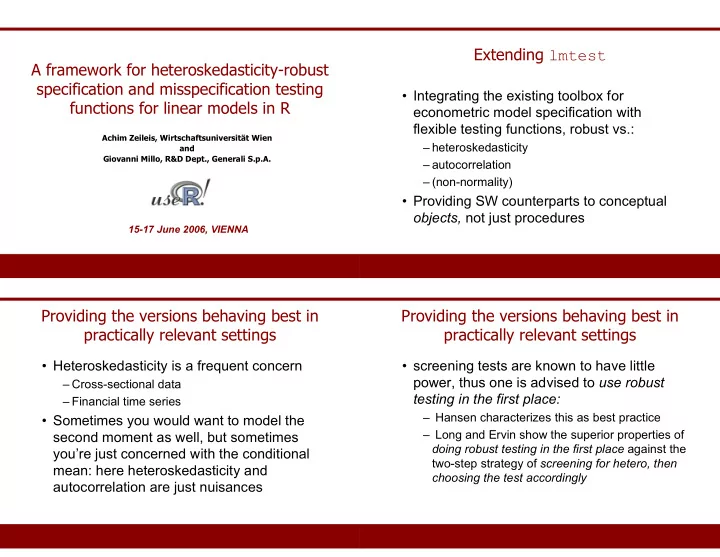

Extending lmtest A framework for heteroskedasticity-robust specification and misspecification testing • Integrating the existing toolbox for functions for linear models in R econometric model specification with flexible testing functions, robust vs.: Achim Zeileis, Wirtschaftsuniversität Wien – heteroskedasticity and Giovanni Millo, R&D Dept., Generali S.p.A. – autocorrelation – (non-normality) • Providing SW counterparts to conceptual objects, not just procedures 15-17 June 2006, VIENNA Providing the versions behaving best in Providing the versions behaving best in practically relevant settings practically relevant settings • Heteroskedasticity is a frequent concern • screening tests are known to have little power, thus one is advised to use robust – Cross-sectional data testing in the first place: – Financial time series – Hansen characterizes this as best practice • Sometimes you would want to model the – Long and Ervin show the superior properties of second moment as well, but sometimes doing robust testing in the first place against the you’re just concerned with the conditional two-step strategy of screening for hetero, then mean: here heteroskedasticity and choosing the test accordingly autocorrelation are just nuisances
Providing the versions behaving best in A comprehensive approach practically relevant settings • asymptotics are of little use in many real- Specification testing: world applications if small-sample properties test M m restriction test are poor H 0 : Rβ=0 for H 0 – MacKinnon and White (1985) developed small- Misspecification testing: sample versions of HC covariance matrix test M m M aux translate restriction test estimators with very good properties H 0 Rβ=0 for H 0 – yet the use of the original, suboptimal HC0 Non-nested model comparison: version is widespread (Long and Ervin, 2000) test M m M encomp translate restriction test M alternative Rβ=0 for H 0 Design principles: Design principles: modularity theory-driven, high-level approach Translating the conceptual approach to sandwich • Reusing tools, e.g. vcovs from sandwich restriction testing (Wald-LM-LR) into software • Making the restriction testing functions through an object-oriented approach: reusable as computing tools for tests based on auxiliary models • explicitly dealing with parameter and covariance – ease of maintenance estimators through their software counterparts – ready to be reused – you don’t need to know what’s inside the box – computationally more intensive, but this isn’t a limitation nowadays in most settings
Design principles: flexibility What is (will be) available Plugging in the appropriate tool for the problem Specification testing: at hand (sensible defaults, but the useR can • coeftest(), waldtest(), lrtest() (scoretest()) choose, or e.g. run multiple tests) • Example: Robust restrictions testing Non-nested models comparison: – a Wald test robust vs. heteroskedasticity and autocorrelation of residuals can be implemented plugging • encomptest(), jtest() in the relevant vcov matrix. • Example: Robust misspecification tests Misspecification/endogeneity – robust Wald and LM tests can be plugged into • grangertest() (bgtest(), reset(), dwhtest(), misspecification tests (e.g. Breusch-Godfrey) or non- whitetest()...) nested tests (e.g. J-test) Is this practically relevant? 1. Is this practically relevant? 2. Motivating example for higher-level misspecification Assessment of small-sample behaviour and HC-robustness of restriction tests under different conditions (Montecarlo) tests: testing serial correlation on highly heteroskedastic financial data (no scientific evidence, just an example) • the standard test rejects the hypothesis of no correlation at any level on some “evidently heteroskedastic” subsamples • the results of the HC-robust test “look far more stable” • is the standard test being fooled by heteroskedasticity into false positives?
Breusch-Godfrey tests on subsamples Standard vs. HC-consistent BG test Model on stock returns, d(tel)~d(sp)+d(nasdaq) 3-year rolling window, std.=orange, HC=green Estimated error heteroskedasticity Log of ratio of 5%-35% to 65%-95% quantiles' variance
Recommend
More recommend